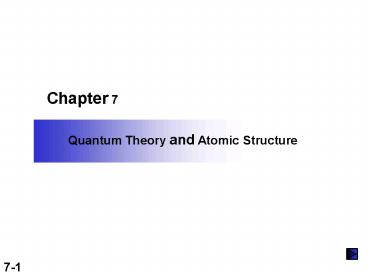Quantum Theory and Atomic Structure - PowerPoint PPT Presentation
1 / 37
Title:
Quantum Theory and Atomic Structure
Description:
7.3 The Wave-Particle Duality of Matter and Energy. 7.4 The Quantum-Mechanical Model of the Atom ... Wave motion in restricted systems. 7-20. Table 7.1 The de ... – PowerPoint PPT presentation
Number of Views:127
Avg rating:3.0/5.0
Title: Quantum Theory and Atomic Structure
1
Chapter 7
Quantum Theory and Atomic Structure
2
Quantum Theory and Atomic Structure
7.1 The Nature of Light
7.2 Atomic Spectra
7.3 The Wave-Particle Duality of Matter and
Energy
7.4 The Quantum-Mechanical Model of the Atom
3
Figure 7.1
Frequency and Wavelength
c l n
4
Figure 7.2
Amplitude (Intensity) of a Wave
5
Regions of the Electromagnetic Spectrum
Figure 7.3
6
Sample Problem 7.1
Interconverting Wavelength and Frequency
SOLUTION
PLAN
Use c ln
1.00x10-10m
wavelength in units given
3x108m/s
3x1018s-1
n
1.00x10-10m
325x10-2m
3x108m/s
wavelength in m
n
9.23x107s-1
325x10-2m
473x10-9m
frequency (s-1 or Hz)
6.34x1014s-1
n
7
Figure 7.4
Different behaviors of waves and particles.
8
The diffraction pattern caused by light passing
through two adjacent slits.
Figure 7.5
9
Figure 7.6
DE h n
Blackbody Radiation
10
Figure 7.7
Demonstration of the photoelectric effect
11
Sample Problem 7.2
Calculating the Energy of Radiation from Its
Wavelength
PLAN
After converting cm to m, we can use the energy
equation, E hn combined with n c/l to find
the energy.
SOLUTION
E hc/l
6.626X10-34Js
3x108m/s
x
E
1.66x10-23J
1.20cm
12
Figure 7.8
The line spectra of several elements
13
R
Rydberg equation
-
R is the Rydberg constant 1.096776 m-1
Three series of spectral lines of atomic hydrogen
Figure 7.9
for the visible series, n1 2 and n2 3, 4, 5,
...
14
Figure 7.10
Quantum staircase
15
Figure 7.11
The Bohr explanation of the three series of
spectral lines.
16
Figure B7.1
Flame tests
strontium 38Sr
copper 29Cu
Figure B7.2
Emission and absorption spectra of sodium atoms.
17
(No Transcript)
18
Figure B7.3
The main components of a typical spectrophotometer
19
Figure 7.13
Wave motion in restricted systems
20
Table 7.1 The de Broglie Wavelengths of
Several Objects
Substance
Mass (g)
Speed (m/s)
l (m)
slow electron
9x10-28
1.0
7x10-4
fast electron
9x10-28
5.9x106
1x10-10
alpha particle
6.6x10-24
1.5x107
7x10-15
one-gram mass
1.0
0.01
7x10-29
baseball
142
25.0
2x10-34
Earth
6.0x1027
3.0x104
4x10-63
21
Sample Problem 7.3
Calculating the de Broglie Wavelength of an
Electron
PLAN
Knowing the mass and the speed of the electron
allows to use the equation l h/mu to find the
wavelength.
SOLUTION
6.626x10-34kgm2/s
l
7.27x10-10m
9.11x10-31kg
x
1.00x106m/s
22
Figure 7.14
Comparing the diffraction patterns of x-rays and
electrons
23
CLASSICAL THEORY
Figure 7.15
Matter particulate, massive
Energy continuous, wavelike
Summary of the major observations and theories
leading from classical theory to quantum theory.
Observation
Theory
24
Figure 7.15 continued
Observation
Theory
25
The Heisenberg Uncertainty Principle
D x m D u
26
Sample Problem 7.4
Applying the Uncertainty Principle
PLAN
The uncertainty (Dx) is given as 1(0.01) of
6x106m/s. Once we calculate this, plug it into
the uncertainty equation.
SOLUTION
Du (0.01)(6x106m/s) 6x4m/s
6.626x10-34kgm2/s
Dx
10-9m
4p (9.11x10-31kg)(6x104m/s)
27
The Schrödinger Equation
HY EY
28
Figure 7.16
Electron probability in the ground-state H atom
29
Quantum Numbers and Atomic Orbitals
An atomic orbital is specified by three quantum
numbers.
n the principal quantum number - a positive
integer
l the angular momentum quantum number - an
integer from 0 to n-1
ml the magnetic moment quantum number - an
integer from -l to l
30
Table 7.2 The Hierarchy of Quantum Numbers for
Atomic Orbitals
Name, Symbol (Property)
Allowed Values
Quantum Numbers
Principal, n (size, energy)
Positive integer (1, 2, 3, ...)
1
2
3
Angular momentum, l (shape)
0 to n-1
0
0
1
0
0
Magnetic, ml (orientation)
-l,,0,,l
31
Sample Problem 7.5
Determining Quantum Numbers for an Energy Level
PLAN
Follow the rules for allowable quantum numbers
found in the text.
l values can be integers from 0 to n-1 ml can
be integers from -l through 0 to l.
SOLUTION
For n 3, l 0, 1, 2
For l 0 ml 0
For l 1 ml -1, 0, or 1
For l 2 ml -2, -1, 0, 1, or 2
There are 9 ml values and therefore 9 orbitals
with n 3.
32
Sample Problem 7.6
Determining Sublevel Names and Orbital Quantum
Numbers
(a) n 3, l 2
(b) n 2, l 0
(c) n 5, l 1
(d) n 4, l 3
PLAN
Combine the n value and l designation to name the
sublevel. Knowing l, we can find ml and the
number of orbitals.
SOLUTION
n
l
sublevel name
possible ml values
of orbitals
(a)
2
3d
-2, -1, 0, 1, 2
3
3
(b)
2
0
2s
0
1
(c)
5
1
5p
-1, 0, 1
3
(d)
4
3
4f
-3, -2, -1, 0, 1, 2, 3
7
33
Figure 7.17
1s
2s
3s
34
Figure 7.18
The 2p orbitals
35
Figure 7.19
The 3d orbitals
36
Figure 7.19 continued
37
Figure 7.20
One of the seven possible 4f orbitals































